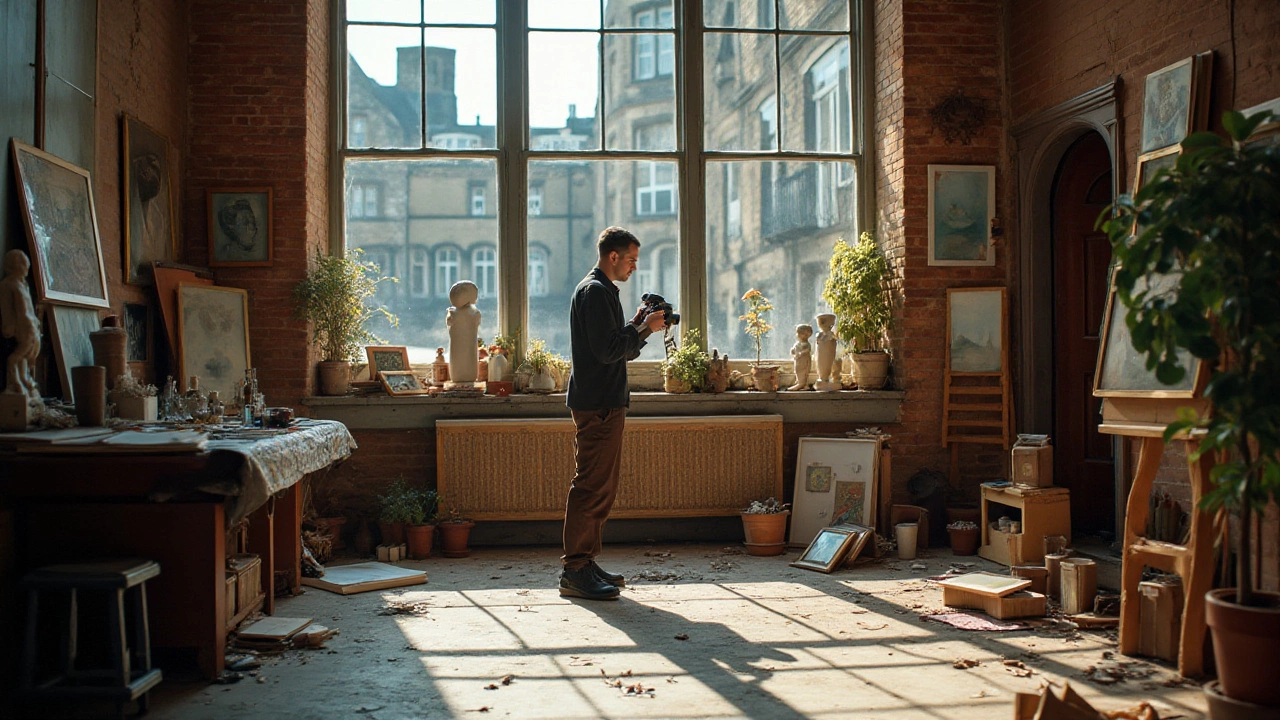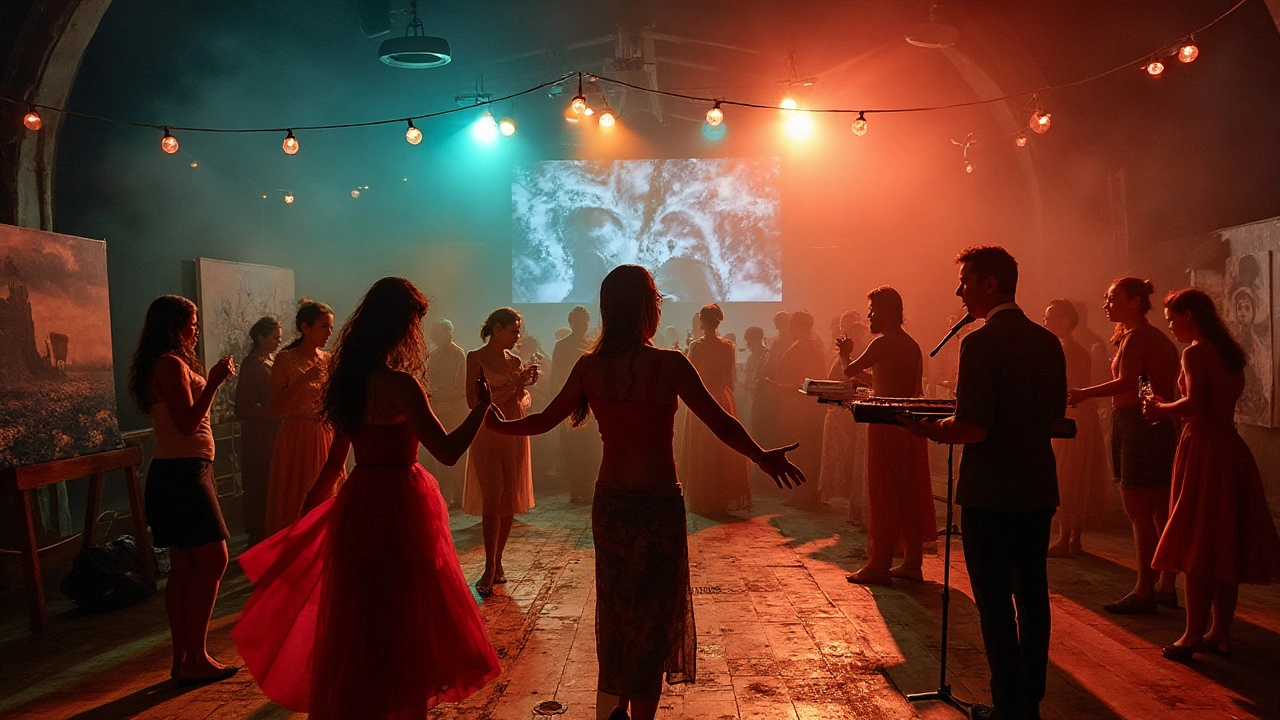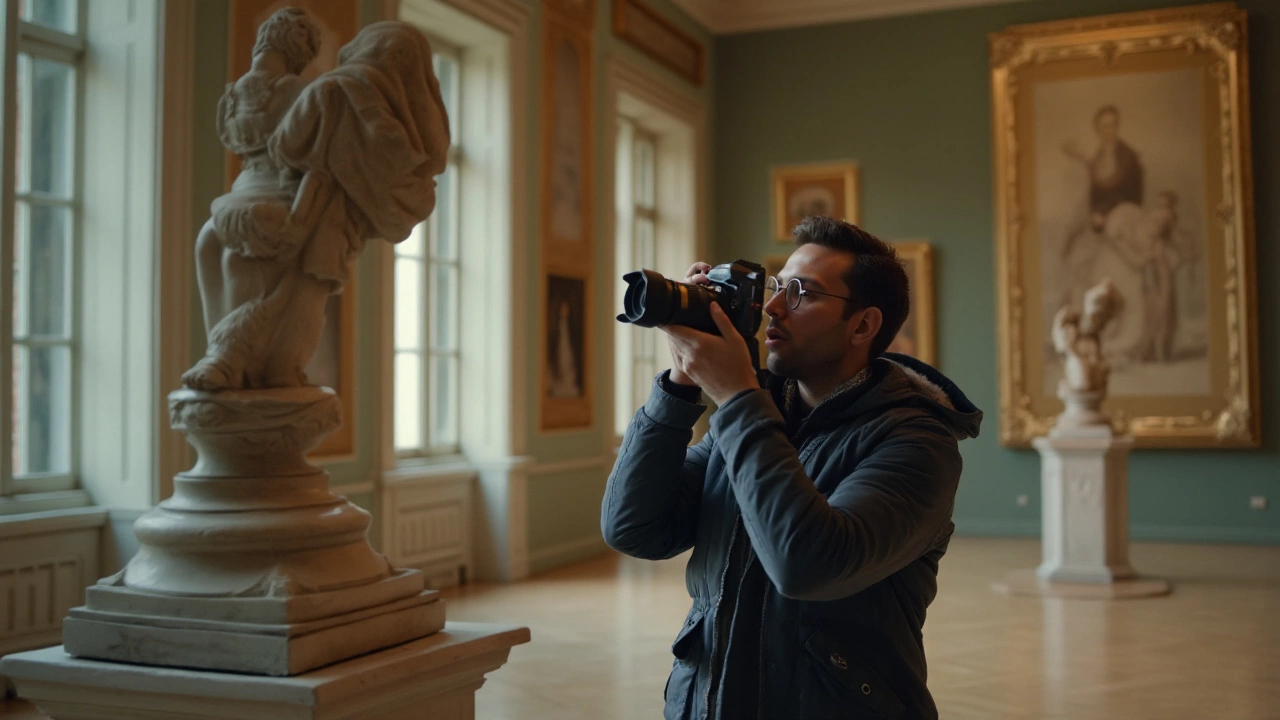The concept of fine arts dates back centuries, representing some of the highest expressions of human creativity. From the gentle sweep of a painter's brush to the haunting melody of music, each art form offers its own distinct window into the human experience. Among these treasured forms, fine art photography stands out, merging traditional visual arts with the contemporary eye.
Exploring how each of these seven disciplines plays a role in shaping our cultural landscape can enhance our understanding of art's profound impact. This article guides you through the vibrant tapestry of art forms, emphasizing the role of photography in knitting them together, both as an individual discipline and as a complement to its fellow arts. Join us in uncovering the unique charm of each, and see how fine art photography crafts visual stories that resonate across time and place.
- The Origins of Fine Arts
- Painting: Colorful Strokes and Beyond
- Sculpture: Frozen in Time
- Architecture: Structures and History
- Music: Rhythms of the Soul
- Fine Art Photography: The Artistic Lens
The Origins of Fine Arts
The roots of the fine arts stretch back into the mists of time, tracing the very essence of human civilization. From the ancient cave paintings of Lascaux that eloquently dance across the cavern walls to the colossal stone figures of Easter Island, art has always been an essential part of human history. It conveys the thoughts, dreams, and mysteries of early peoples who, armed with only basic tools and boundless creativity, sought to capture their realities as well as their imaginations. Understanding the origins means looking at the very core of human expression, how philosophy, religion, and daily life intertwined to birth these beautiful canvases of existence.
Art historians often mark the period of Ancient Greece as a foundational era for the formalization of the art forms we know today. The Greeks explored not just the aesthetic but the ethical and dramatic potential of art through their architecture, sculptures, and theater. It was in this cultural hotbed that “techne,” a concept lauding craft and skill, began to take on an artistic connotation, influencing Western artistic thought for millennia. Reflecting on the role of art in antiquity reveals a time when mediums like sculpture and drama were not mere leisurely pursuits but integral to a community's identity, politics, and religion.
As societies evolved, so did their art, influenced by exploration and contact with distant civilizations. The intricacies of Middle Eastern architectural motifs found echoes in European structures, as the Silk Road blended traditions and styles. Art became a kaleidoscope of encounters, enriched by diverse influences. A common thread in this tapestry is the human spirit's desire to capture beauty, narrate stories, and make meaning. By the time of the Renaissance—a term that literally translates to 'rebirth'—a cultural awakening had swept through Europe. It revived old paradigms while birthing new ones, setting a pivotal stage for the flourishing of visual arts and laying a robust foundation for future discoveries and creations.
The power of art to transcend time and place was eloquently captured by Pablo Picasso who said, "Every child is an artist. The problem is how to remain an artist once he grows up."
The evolution of art traversed beyond European confines, flourishing, for example, within the grand dynasties of China, where not only calligraphy and painting but also porcelain craft reached unparalleled heights. Similarly, the vibrant artistic traditions of Africa with their powerful masks and spiritual carvings provided vital insights into their cultural values and rituals. Each of these realms, while distinct in their expressions, highlights the universal embrace of art across human societies. These multifaceted journeys reveal how art connects individuals to their shared humanity, preserving past legacies while continuously inspiring future generations towards innovation and enlightenment.
Painting: Colorful Strokes and Beyond
Throughout history, painting has mesmerized and inspired humanity with its vibrant colors and expressive imagery. Going back to the frescoes of ancient Pompeii and the grand canvases of the Renaissance, painting has been a dynamic means of storytelling, capturing the moments that words cannot fully express. From cave walls to towering ceilings, these colorful strokes have charted human emotion and intellect over centuries, evolving with every era and movement. Different styles, from the delicate lines of the Impressionists to the bold shapes of abstract expressionism, have emerged, each offering a unique perspective and society's reflection on art.
While the tools and techniques of painting have undoubtedly evolved, the purpose often remains the same – to evoke emotion, provoke thought, and capture the artist's worldview. The Impressionists, for instance, revolutionized the arts with their emphasis on light and color, challenging the more formal representations that came before. In this vibrant dance of colors, artists like Claude Monet and Edgar Degas opened up new avenues of seeing and showed the power of brush and canvas. Here, painting is not just a craft; it becomes a dialogue, an unspoken communication between the artist and their audience. It is said that the artist's brush never lies, reflecting the inner truths, fantasies, and struggles of its wielder.
“Every artist dips his brush in his own soul, and paints his own nature into his pictures.” - Henry Ward Beecher
Today's painters stand on the shoulders of giants, benefiting from techniques and insights developed by painters throughout the ages. Yet, they also face new challenges and opportunities presented by the modern era, including the rise of digital media. Many contemporary artists experiment with mixed media, integrating technology with tradition to further the boundary between paint and expression. The advent of digital platforms offers painters a global stage, democratizing art and allowing fresh voices to rise and be heard in unexpected places. Still, at its core, painting is about the simple joy of color, form, and emotion, an irreplaceable medium in the diverse world of fine arts.

Sculpture: Frozen in Time
Sculpture stands as one of the most enduring and fascinating forms of fine arts, a timeless testament to human craftsmanship and creativity. This ancient art form traces its origins back to prehistoric times when individuals first carved figures from stone and wood. As centuries unfolded, cultures around the world embraced sculpture as a medium to express spiritual, political, and personal narratives. Each sculpture is a conversation with time itself—capturing stories, beliefs, and emotions in a form that resists the erosion of memory, offering a tangible link to the past.
The diversity in materials and techniques has only enriched the art of sculpture. From the classic marble statues of Greece, celebrated for their precision and beauty, to the bronze castings of the Renaissance, such as Michelangelo's David, these works reflect cultural shifts and advancements in technology. The modern era ushered in a wide array of materials like metal, glass, and discarded objects, redefining what sculpture could be. Artists today continue to push boundaries, with contemporary installations prompting us to reconsider space and form in new contexts.
Sculpture has also witnessed transformative movements, each contributing distinct philosophies and aesthetics. The Baroque era introduced dynamic compositions characterized by movement and drama, a stark contrast to the simplicity and serenity sought by neoclassicists. Similarly, the abstract forms of 20th-century artists like Henry Moore and Alberto Giacometti challenge traditional views, urging observers to contemplate not just the object, but the space it inhabits.
"Sculpture is the art of the hole and the lump," said the renowned sculptor Henry Moore, encapsulating its inherent duality.
The role of sculpture extends beyond mere artistry; it serves as a reflection of societal values and aspirations. Public monuments commemorate historical events and figures, whereas religious sculptures hold sacred significance in temples and cathedrals worldwide. In modern cities, sculptures have become integral to urban design, transforming landscapes and providing moments of reflection amidst the bustle of daily life. The fusion of art and environment highlights how sculpture continues to evolve, retaining its relevance and revered status in visual arts.
Fine art photographers have long admired sculptures, using the camera lens to capture their essence in unique perspectives. By understanding the play of light and shadow on sculpted surfaces, photographers can reveal new dimensions and emotions. This symbiotic relationship between sculpture and photography not only enriches the field of fine art photography but also immortalizes sculptures in fresh, unexplored ways. Through the lens, these 'frozen in time' pieces find dynamic new life, proving the enduring connections between these two forms of expression. As we observe and capture these masterpieces, we partake in an artistic dialogue that spans geographies and generations, a testament to the resilience and adaptability of human creativity.
Architecture: Structures and History
Architecture stands as a testament to human ingenuity and imagination, framing not just our physical world, but our cultural and historical landscape as well. Through magnificent structures, from ancient temples to modern skyscrapers, it tells tales of past societies and aspirations for the future. Take, for instance, the pyramids of Egypt, which encapsulate a longing for immortality and remain as sturdy monuments of human ambition and skill. The evolution from the grandeur of Gothic cathedrals to the simplicity of modernist design reflects the dynamic dialogue between space and aesthetic principles.
In uncovering the layers of architectural history, one discovers how different eras have used architecture as a form of expression and innovation. The aqueducts of Rome not only display engineering brilliance but also emphasize how architecture can transform societies by addressing basic needs such as water supply. Fast forward to the 20th century, when architects like Frank Lloyd Wright and Le Corbusier sought harmony with nature, balancing functionality with beauty, reshaping how we perceive the spaces we inhabit. Such landmarks redefine life's possibilities by altering how people interact with their environment, forging a shared cultural heritage that continues to influence new generations.
"A building has integrity just like a man. And just as seldom," mused the renowned American architect Ayn Rand, encapsulating the spirit that guides architectural endeavors. This integrity speaks volumes, not just in structural resilience but in the inextricable link between utility and artistry. Whether it's Borobudur or the Sydney Opera House, each architectural masterpiece challenges and inspires, encouraging us to think beyond mere shelter and embrace the aesthetic and environmental implications of our designs.
The intersection of architecture and photography further provides a unique opportunity to capture the essence and soul of these edifices. Through the lens, the play of light and shadow, the intricate detailing and vast open spaces come alive, offering viewers a new perspective. In doing so, photographers help preserve the integrity of these structures, ensuring that their stories endure. Their art not only serves to document but also interprets what these physical forms symbolize, making fine art photography an essential companion to the world of architecture.

Music: Rhythms of the Soul
Music is a magical form of art that knows no boundaries. It's something that resonates with everyone, across cultures and generations. The rhythmic beats and melodies can evoke emotions, paint vivid memories, or even spark revolutionary ideologies. Music is often referred to as a universal language, and rightly so, as it can connect people regardless of what verbal languages they speak. Beethoven once said, 'Music is the mediator between the spiritual and the sensual life,' reflecting how deeply it touches our core.
The history of music traces back to the dawn of human civilization. The earliest indications of musical instruments were found in archaeological sites, with flutes made from bones that date back thousands of years. The evolution of music has seen the advent of numerous instruments and styles, from classical symphonies to lively jazz, from soulful blues to dynamic hip-hop. Each genre offers its distinct flavor, influencing societies and cultures dramatically. In fact, music is so integral to some cultures that it forms the backbone of their rituals and traditions.
In today's world, the creation and consumption of music have been revolutionized by technology. Digital platforms have made it possible for artists to share their work with a global audience instantaneously. Streaming services have not only changed how we access music but also how artists make a living. These changes, while sometimes controversial, provide fascinating insights into the growth and adaptation of this art form. Music's role in entertainment, education, and even therapy underscores its profound impact on human lives.
Music also draws lines of connection with other forms of art. In paintings and sculptures, the musical themes often find their representation, capturing the same emotions and cultural discussions that music ignites. For instance, Kandinsky's abstract paintings are said to reflect musical compositions. Similarly, fine art photography often uses music as an inspiration to capture rhythm and motion. A photograph of a street musician can tell a story as profound as the song being played, freezing a moment that captures the essence of music and life.
The scientific study of music's effect on the human brain has revealed some intriguing results. Music can boost mood, improve cognitive functions, and even heal psychological wounds. Listening to certain types of music can release dopamine, the feel-good neurotransmitter, proving that this art form is more than just pleasant sound. Notably, a study published in Nature Neuroscience showed that music activates emotional responses and reward systems in the brain, much like food or pleasurable activities do. The connection between mind and music is deep, sometimes inexplicable, but always fascinating.
For those seeking to explore music as a means of artistic expression, many find inspiration in the visual arts. The interplay between the fine arts creates a dynamic landscape where inspiration flows freely in both directions. Fine art photography, for instance, often captures images that reflect the rhythm and mood of music, creating a visual symphony that compliments the auditory. Artists and photographers alike find muse in the ebbs and flows of musical scores—emphasizing how these two art forms enrich one another, enhancing the overall experience of creativity and expression.
Fine Art Photography: The Artistic Lens
In the rich tapestry of fine arts, photography stands apart with its unique ability to capture the ephemeral essence of moments. Unlike traditional forms bound to physical materials like canvas or stone, photography is an interplay of light and time, allowing artists to portray perspectives that are both fleeting and timeless. At the heart of fine art photography is the photographer's vision—a pursuit that blends technical prowess with imaginative expression. This form of art engages the eye and the mind, using the camera as a tool to interpret the world in intimate and infinite ways.
The rise of fine art photography can be traced back to pioneers like Alfred Stieglitz and Ansel Adams, who pushed the boundaries of what photography could achieve. They demonstrated that photography was not merely about documentation but could elevate a scene to evoke emotions akin to those stirred by paintings and sculptures. Ansel Adams, with his iconic black and white landscapes, showcased the delicate interplay of shadow and light, turning nature scenes into transcendent pieces of art. He once remarked, "You don't take a photograph, you make it," a sentiment that underscores the intentionality behind each shot in fine art photography.
A critical aspect of fine art photography is its narrative quality. Each photograph tells a story—a whisper of the past, a vivid dream of the future, or an abstract pondering of the present. This narrative can be real or imagined, crafted by elements such as composition, lighting, and subject matter. The photographer's ability to weave a compelling story through their lens sets fine art photography apart from other photographic genres. This storytelling process often involves meticulous planning and creativity, ensuring that every frame reflects the photographer’s unique point of view.
Emphasizing art forms in photography often involves exploring themes like identity, culture, or nature, which resonate universally. Contemporary photographers incorporate a plethora of techniques, from digital manipulation to mixed media, to expand their expressive range. Notable artists in this field continue to leverage new technologies, blending traditional methods with innovative ones through dynamic processes. The role of color, texture, and form becomes crucial here, allowing for a broader dialogue between artists and audiences across diverse visual landscapes.
The visual arts are deeply linked to fine art photography, as photographers draw inspiration from the masters of painting and sculpture. Consider the influence of Caravaggio's chiaroscuro on photographic lighting, or the compositional inspiration borrowed from Renaissance art’s exploration of symmetry and perspective. These cross-disciplinary connections enrich the field, encouraging aspiring photographers to view their craft as an extension of the broader artistic community.
Modern fine art photography also finds itself at the intersection of digital innovation and traditional technique. The emergence of high-resolution cameras and editing software allows photographers to explore new dimensions of creativity, challenging the conventions that once defined the boundaries of their work. An essential tool in the fine art photographer's arsenal is photo editing, enabling them to enhance the storytelling potential of their images while retaining the integrity of the original shot. As technology evolves, so will the means through which photographers express their vision, ensuring the evolution of this vibrant and ever-expanding art form.

